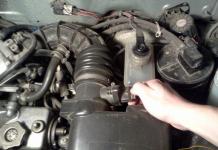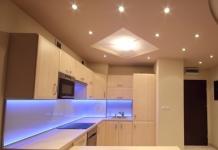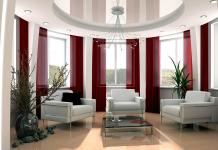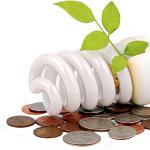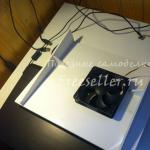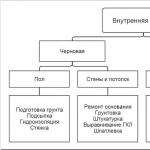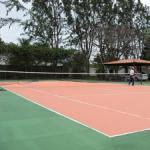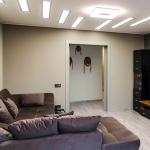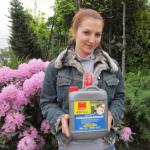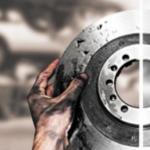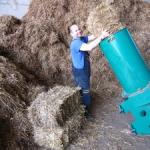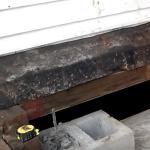Covering for tennis courts Hard is relevant for playing tennis, due to its characteristics. While playing on such a surface, tennis players feel confident and comfortable; The matte HARD structure eliminates glare, while the ball's minimal energy absorption and excellent visibility make the surface ideal for both training and sports competitions;
Properties Hard
The properties of the site construction material are stable for use in a wide temperature range from -50 to +50 degrees; An almost perfect plane is achieved using a special alignment technology. The HARD structure has several layers applied in a certain way, resulting in a uniform surface with excellent performance characteristics, which include color, texture and elasticity;
Depending on the number of softening layers with rubber crumb and the content of quartz sand in the composition, you can adjust the speed of the ball rebound.
The construction of tennis courts in Moscow is carried out by Sport-Pokrytie LLC, which has more than 15 years of experience in this field; The price of specialized HARD compounds for tennis courts is fully consistent with its quality, the guarantee from the company is 3 years
At the preparatory stage of the construction of the site, concrete is first poured, which is covered with a special acrylic polymer composition on top.
The professional composition for use on HARD tennis courts is durable and comes in a wide range of colors; HARD - coating is one of the most convenient for playing tennis, its surface is quite hard, consists of several layers of special polymers, which allows you to clearly control the rebound of the ball and keep the game under control.
Hard has quality assurance and long service life. In addition, Hards are used in professional ITF competitions.
* The company "Sport-Pokrytie" LLC has been laying and supplying material for tennis courts for over 15 years. Our experienced experts will provide professional advice and equip a reliable surface for the sports ground in a short time at the best price.
When choosing a tennis surface, it is important to determine the right amount of padding and the right level of hardness. The most versatile option is Hard on a rubber roll substrate (Regupol/Kraiburg). Championships are held on it, the surface is certified by the ITF (International Tennis Association).
Sports coverage HARD, varieties and structure
HARD (Hard) is the most practical and unpretentious material in use. It consists of several layers, usually from 5 to 14, which are acrylic polymers of varying degrees of rigidity.
The coating of HARD tennis courts contains functional layers, softening and finishing (marking).
The functional layers serve to form its properties, the softening properties are important for the rebound of the ball and for the players' joints.
Often, during the construction of playgrounds, a special rubber backing is used as the first layer, which is an excellent shock absorber, makes use more comfortable and safe, in addition, the rubber backing under the HARD bulk layers helps to ensure the evenness of the surface when the base is not too even.
The price of the HARD coating (Hard) depends on the number of layers and the presence of a softening substrate. By purchasing material from us, you get guaranteed high quality and coatings tested by professional players.
The rubber backing is attached to the base of the site and provides additional softening, allows you to maintain the structure of the material for a long time, due to the unique cushioning properties.
HARD professional sports flooring is used during competitions, trainings of professional tennis players, suitable for amateur courts. Can be used for other sports. In the case of a multisport platform, the use of additional cushioning or a rubber backing is recommended.
Shock-absorbing underlay made of recycled rubber crumb, attached to the base with heavy-duty glue and provides additional softening, allows you to maintain the structure for a long time, due to the unique shock-absorbing properties;
The material is laid in several stages: First, you need to prepare the base. For a sports surface, the evenness of the base is extremely important: It should be free of cracks, potholes, etc., in some cases a leveling screed is sufficient, but it is much better if the concrete or asphalt base is initially arranged in an absolutely even layer.
This is due to the fact that the material has a structure that, like a self-leveling floor, completely repeats the surface of the site.
* With a properly prepared base, the future court will be usable for as long as possible, more than 15 years, no puddles will form on it. Therefore, the preparatory stage when arranging a tennis court is extremely important: compliance with technologies, building codes, creating a site slope over the entire plane, thermal seams.
The structure of the Hard sports coating is such that in case of minor damage it will be enough to locally repair the surface by filling it with a small amount of polymer.
When choosing a sports surface, it is recommended to take into account the future intended use: if the players are experienced, who prefer a fast game, then the HARD material is chosen quite hard, with the fastest ball rebound.
We recommend using a 4-6 mm rubber backing or additional softening, this will make the game more comfortable and safer. This becomes especially relevant if children play tennis.
Additional softening layers are added to the composition, there can be up to 8 of them, but the minimum softening that it is desirable to add to all sites is 2 layers.
The use of rubber backing in the construction of tennis courts
The average service life is 15 years, while, in case of minor damage, it is enough to locally repair problem areas, renew the top and marking layer, and the site will again be like new, at minimal cost.
Unlike the versatile rubber surfaces on a tennis court, HARD allows you to play more dynamically. Experienced tennis players know how important an accurate ball rebound and flatness of the ground is for accurate shot placement and the ability to play along the edges of the lines.
Most professional competitions are held on Hard, this material has long earned a special love among tennis players.
Dimensions of a standard tennis court
23.77m x 10.97m - doubles area,
23.77m x 8.23m - single player area.
Total area 648 m2 (with races)
In the final third part of the article, we will talk about clay and grass courts. For objective reasons, which we will discuss below, these types of coverage are inferior in terms of prevalence to hard. The grass season lasts just over 1.5 months. And if you discard Wimbledon, even less so. On the other hand, this has its advantages. That kind of uniqueness makes big clay and grass tournaments special in a way, and elitist, if you will. Not without reason, victories in Grand Slam tournaments on clay (French Open (RolandGarros)) and on the grass (Wimbledon) are valued by athletes and amateurs higher than the victories on US Open (US-Open) or Australian Open (AustralianOpen). Although nominally the last two tournaments are also part of the Grand Slam tournament series.
Clay courts
In terms of construction and operation, these are usually the most economical courts. This type of coating is also referred to as the least traumatic. Therefore, it is recommended to play it for adults, children, and beginners. But what does it mean "tennis ground"? This is certainly not the usual "land" as some aspiring tennis players think. To cover these sites, a mixture of natural materials is used in various combinations and proportions: sand, clay, brick chips, etc. Hence the color of clay courts. The most common is "red ground" used mainly in Europe and South America. Tournaments are held in the USA "green ground".
Clay courts are the slowest type of surface. The bounce of the ball is usually high. The rallies are long and the more the ball is in play, the more it becomes heavier, as it "collects" the ground. Of course, a strong serve and on the ground will not hurt. However, ceteris paribus, on this type of surface, the advantage is given to "runners-players", i.e. tennis players who are able to withstand a long exchange of blows on the back line, have good endurance and prefer combination tennis. Therefore, doing tennis betting, these seemingly elementary truths regarding the specifics of the game on the ground should be taken into account.
Grass courts
Natural grass courts in the expanses of the former USSR are very rare. What can we say about the post-Soviet region, if in Europe, they are a curiosity, and more or less common only in Germany and the UK. Several grass tournaments are also held in the USA. All this is explained by objective reasons: the high cost of construction and the complexity of operation. It is constantly necessary to monitor the quality of the grass "carpet" and carry out regeneration measures in a timely manner.
Grass is considered the fastest surface in tennis. The ball bounces fast and low. Draws are usually over in a few strokes. Tennis players of an aggressive style get the advantage on the grass. In a game between two players who serve well, other things being equal, the stereotypical bet is "total games over".
On this "trilogy" about the types of coverage of tennis courts came to its logical conclusion. I hope that the information presented in the articles will at least slightly allow beginners in sports betting to improve the quality of their tennis predictions. AND remember that you cannot consider the court coverage factor in isolation from other data (physical and psychological form, motivation, etc.)!
Good luck in your bets and everyday affairs!
Recently, it has become popular to ennoble summer cottages, to make them more comfortable for recreation. Today, swimming pools, gazebos, a golf course, courts, etc. are being built in the country. The court (platform) is intended for playing tennis. In this article we will consider the construction of a tennis court on the site.

Before starting construction, it is worth deciding on the location of the future court, and for this you need to know its allowable area. The European standard court size is 18 x 36 m, for a single game the size is 23.77 x 8.23 m, this is an area designed for races and other game moments. For beginners and children, courts with dimensions of 17 × 34 m or 16 × 32 m are suitable. But do not forget that children grow up, and a novice tennis player will soon gain experience, so it will, of course, be problematic to increase the boundaries of the rebuilt site later.
When building a court, the most important aspects are the choice of surface, fencing and lighting.
The main thing during the construction of a tennis court is to adhere to some rules, especially if you want to get a professional court. This is not only accurate markings, but also special baskets for balls, and many other necessary things. The fencing of the court is done mainly with the help of a chain-link mesh, which is stretched between metal pipes. Its height should be such that the ball does not fly to neighboring areas, that is, 3-4 m will be enough. Lighting also occupies not the last place. If you like to play in the evening, you will need from 5 to 10 lamps, the power of which is more than 200 watts. They should be on a mast 6-8 m high.
Protection from rain, wind or snow will be structures made on the basis of a frame or sandwich panels. These buildings, equipped with a heating system, will survive any weather.
The main and expensive part of the court, of course, is its surface. There are different types of tennis court surfaces, the material of which greatly affects the quality of the game itself. Naturally, with any option chosen, it will be necessary to lay the foundation, that is, to prepare the site. To do this, you need to level the ground, create a "cushion" that will serve as a drain for moisture. The type of "pillow" depends on the coverage you choose.
The main types of surfaces for tennis courts are: clay, grass, carpet and hard courts.
Types of tennis court surfaces
Priming
For a court in a summer cottage, a ground cover is best suited. It is considered less traumatic, which is important for children and adults. Ground coating will avoid heavy loads on the legs and spine during the game. Well, the advantages include its fairly quick construction (somewhere from 3 weeks) and relatively low cost. But at the same time, a clay court requires more attention during operation: it takes a long time to dry, it needs to be thoroughly cleaned of foliage, in hot weather it needs to be watered for about five minutes, and in the spring it needs to be repaired. If you run a clay court, grass can grow on it in the spring. To avoid this, it is necessary to repair the site every year, this will require about 3-5 tons of tennisite (this is a special mixture of sand, brick and marble chips, clay and other components that form a coating for a clay court). About 40 tons of tennisite is recommended for a standard court, the height of which in compacted form will reach up to 4 cm. For proper care of a clay court, it must be remembered that the court should not be too dry and wet, and after the game it is advisable to walk around the court with a special brush.

"Hard"
The coating, called "hard", is made of acrylic, it is used in the construction of sports fields and tennis courts. Its color scheme is very diverse. "Hard" has proven itself well on indoor and outdoor courts. The area under this coating must be concreted or asphalted. Laying in 3-4 layers is classified as a hard type, and a coating that has more than seven layers is considered a safety option.
This type of coating is quite reliable and, with good preparation of its base, can last more than ten years and does not require special care. You can use the hard coating already in April, and after heavy rain, you just need to collect the water with a rubber squeegee. The disadvantages include too long period of its construction - about two to three months.
Plastic
For an amateur level, a plastic coating is suitable. It is assembled quickly and easily from individual modules. Plastic coating, as well as "hard", is mounted on a solid base, it does not require special operating conditions and allows for quick drainage. The disadvantages include its instability to our climatic conditions. Therefore, when buying it, it is important not to forget to ask the seller about the availability of a guarantee for the material.
Grass
Grass courts are the standard. They are often used when holding solid tournaments, but this does not mean at all that they do not have disadvantages. The bounce of the ball and other parameters that affect the game depend on the state of the lawn. In addition, such a court requires professional care, which is not so easy to organize on the site.
There is also artificial grass, it consists of polypropylene fibers. There are two types of grass: backfill, the length of its pile reaches 20 mm; semi-filled - has a pile 10 mm long. Synthetic fibers are woven into a flexible latex base. After laying, all this is covered with quartz sand from above. Artificial grass can be laid on a dense "cushion", which is made of granite screenings or on a concreted surface.
This tennis court surface requires watering, because the degree of moisture depends on the stiffness and how quickly the ball bounces. Sand, like soil, will eventually need to be topped up or simply leveled, and in dry weather it must be moistened. The disadvantages include that if there is too much moisture, artificial grass cover will be too slippery.
The basis
The site for the construction of a tennis court will be prepared depending on the chosen surface. By the way, errors and inaccuracies during the construction of the foundation can reduce the merits of durable and expensive materials. The depth of the excavation under the base is from 40 to 60 cm, and the thickness of the concrete layer is 15 cm.

And the need for pre-backfilling for a solid base of crushed stone and sand will depend on the type of soil. For a smooth and dense surface, these layers are best rolled with a construction roller. To make the tennis court dry better, it is made with a slight slope: on the short side - from 0.5% to 1%. A system for removing excess moisture in the form of gutters should be provided in advance by the builders.
Addition to the court
To use the court, you need a variety of equipment and accessories. Any court must have a net and posts for it, baskets for balls. To level the ground cover, you will need a rake. To cover "hard" you need to purchase a roller that removes moisture, as well as a plastic cleaner for marking lines and a machine for collecting balls.
Building a tennis court on the site is a very laborious and costly business that pays off with the pleasure of the game.
Class tennis is a great way to relieve stress and give the body the maximum load. When moving across court you have to use all muscle groups, from the legs to the shoulders and neck. And aerobic exercise allows you to saturate the cardiovascular system with oxygen and effectively strengthen it.
What you need to know about the tennis court
For training and holding tennis competitions, it is required special playground - court. Its size is limited by the standard to a length of 23.78 m (26 yd). And the width varies depending on the type of game: for singles it is 8.23 m (9 yards) and for doubles - 10.97 m (12 yards). 
The playing part of the court is outlined by white lines:
. back - along short ones;
. and lateral - along the long sides of the site.
In the middle, across the entire width, it is stretched, which is attached to the posts, installed 0.914 meters (1 yard) behind the sidelines. The distance from the ground to the top of the net at the posts is 1.07 m (1 yd 6 in) and 0.914 m in the middle of the court.
The feed zone is marked with a special line. It is drawn 6.4 meters (7 yards) from the net, parallel to it, between the singles touchlines. From it to the net goes the middle line, dividing the service area into two equal parts. All marking strips are an integral part tennis court. Even the ball that touched them is considered counted. The space behind the side lines by at least 3.75 m and behind the back lines by 6.5 m is equipped with the same surface as the main playing court - tennis players will move there during the game.
Types of tennis courts

According to the type of coverage, all courts are divided into: clay, carpet, and asphalt. Each of the types of the selected surface has a different effect on the rebound of the ball, which directly affects the strategy of the game and preparation for it. Many professional tennis players show an excellent game on the clay court and at the same time lose in all respects on the grass.
In the beginning, tennis was played purely on open grass courts. courts, from or lawn, which are characterized by the fastest and lowest rebound of the ball. The nature of the game on them largely depends on the current state of the grass and the existing unevenness of the soil, as well as the weather.
Then dirt platforms appeared, the coating on which consists of sand with clay and crushed stone or brick. On modern courts or plastics were added to this mixture. The rebound of the ball on the ground is slow, but as high as possible. 
Then began the age of synthetics. "Hard" has become popular, having an asphalt or concrete surface at the base, covered with a synthetic layer of. Different compounds of synthetics affect the rebound characteristics in their own way, but in general this option is considered the second fastest after grass.
During construction courts synthetic carpets have also been used, which slow down the speed of the game due to their softness, but they are ideal for indoor tennis facilities. The remaining options are not used at official competitions, but are quite widely used for training and equipping personal gyms.
General rules for the location of the court and the necessary equipment for it

Before starting construction tennis court make sure that there is enough space in the selected area. Taking into account the side corridors and runs behind the back line, you will need a rectangle measuring at least 18x36 meters.
For correct orientation, the long side of the court should be stretched from south to north so that the sun does not blind the eyes. Plus, for a closed area, you will need a place for arranging the walls of a sports facility, and for an open one, you will need to take care of the drainage system and a special windproof background.
In addition to the coverage, you will need to make good coverage from all sides, for an open court also a net so that the balls do not fly too far. Lighting masts for the amateur level are located at the four corners of the site, and for professional competitions, eight towers with a height of 6 meters or more will have to be made. 
Over covered closed courts care should be in accordance with the requirements of its manufacturer. The main thing in this case is to monitor the general cleanliness and prevent people in spiked shoes from moving along it. But the grass and unpaved areas will require some effort: after each game and at night they should be spilled with water. The grass, if it is natural, will have to be constantly cut, and the soil leveled with a rake. And don't forget to update the markup each time.
Tennis (tennis)- a sport in which two players or two teams of two people compete with each other. The goal of each of the players / teams is to throw the ball to the opponent's side with a racket in such a way that the opponent cannot reflect it. In this case, the ball must touch the opponent's half of the field at least once.
The history of the emergence and development of tennis
The predecessor of tennis is considered to be the French game "jeu de paume" (French jeu de paume, literally playing with the palm of the hand). Unlike modern tennis, jeu de paume was played indoors and with the palm of the hand. Later, the palm was replaced by gloves, gloves were replaced by special bits, and only then did rackets appear.
One of the most famous references to tennis in medieval literature is the episode in Shakespeare's historical chronicle "Henry V", where the French dauphin sends a keg of tennis balls to the young English king in mockery.
Almost all French kings played tennis, Charles IX called tennis "one of the most noble, worthy and healthy exercises that princes, peers and other noble persons can do."
In 1900, students at Harvard University decided to organize a tournament for national teams. One of the students, Dwayne Davis, bought a silver cup for the winner at his own expense, and most importantly, drew up the rules for the tournament. Davis and two of his friends played for the US team, which won this tournament, and then the next in 1902. The Cup was held every year and was subsequently called the "Davis Cup", which is still a popular event in the world of tennis.
Beginning in the 1920s, professional tennis players began to earn money playing exhibition matches. The first professional tennis match in history took place on October 9, 1926 in New York at the Madison Square Garden indoor arena, in the presence of 13,000 spectators.
Tennis Rules
Players or teams must be on opposite sides of the net. One of the players is the server, the second, respectively, the receiver. The serving player must send the ball in such a way that it hits the court area in the opponent's half. The receiving player must have time to redirect (beat) the ball to the opponent's side before it hits the court or before it touches the court a second time. If one of the tennis players missed the ball, then his opponent gets a point.

A tennis match consists of “sets”, and these in turn are “games”, for which you need to score goals (minimum 4 goals: 15-30-40-game, but with a difference of at least two goals). When serving, the player has two attempts in which he alternately serves the ball into the left and right squares. After the game is played, the serve goes to the opponent. After playing an odd number of games, the players are given a one-minute break and the side is changed. The player who wins 6 games first (provided that his opponent won no more than 4 games) is considered to have won the set. To win a match, you must win 2 out of 3 or 3 out of 5 sets. The one who gets the required number of won sets wins the match.
The rules for doubles in tennis are slightly different from singles, namely:
- the match takes place on a larger court;
- the ball is beaten off by the one who is in the best position;
- players of each team serve in turn;
- Players accept serves only from their side throughout the entire set.
At official matches there is a referee, he is on the tower. In addition to the referee on the tower in the match, there may be referees on the line who record the ball hitting the court area. Since 2006, tennis has been in the era of electronic refereeing systems (Eye of the hawk), which determine the place of the ball's fall with high accuracy.
Tennis court
The standard size of a tennis court is 23.77 meters long and 8.23 meters wide (10.97 meters for doubles). The area of the tennis court is about 196 m2. For the arrangement of tennis courts intended for competitions, an area equal to 668 m2 is required. The court has a rectangular shape with a flat surface with markings applied to it:
- The lines along the short sides of the court are called the back lines, and those along the long sides are called the lineouts.
- Service zones are marked on the court with service lines parallel to the back lines and the net, 6.40 m from the net and drawn only between the side lines for singles, and a center service line drawn in the middle of the court parallel to the side lines and between the service lines . The center service line is also displayed on the net by a vertical white stripe stretched from the surface of the court to the top of the net.
- A short mark is applied to the back lines, indicating their middle.

In the middle of the court, a net is stretched, which runs along the entire width and divides it into two equal parts. The standard tennis net size is 1.07 meters by 12.8 meters, and has square cells with a side of 4 centimeters.
Types of coatings for tennis courts:
- herbal (grass),
- ground (clay),
- solid (hard),
- synthetic carpets (artificial grass, acrylic coatings).
There are other types of tennis court surfaces, such as asphalt, wood or rubber surfaces, but they are not used in official matches. Tennis courts are open and covered.
Tennis equipment
Tennis equipment: tennis racket and ball. The racket consists of a handle and a rounded rim with stretched strings. Racket rim is made of complex composite materials (ceramics, carbon fiber, metal). Tennis racket strings can be either natural or synthetic. Previously it was believed that natural strings have better characteristics, but today artificial strings have caught up with natural strings in terms of characteristics. Interestingly, the tension force of horizontal and vertical strings is usually different. Typically, a tennis racket is selected individually for each player.

There are special requirements for rackets from the International Tennis Federation (ITF):
- The length of the racket must not exceed 73.66 cm.
- The width of the racket must not exceed 31.75 cm.
- The size of the stringed surface of the racket, that is, the internal dimension (to the rim) is 29.21 cm wide and 39.37 cm long.
The game is played with a yellow-white rubber ball. Outside, the ball is covered with fluffy felt to give certain aerodynamic properties.

tennis tournaments
- In modern tennis, the 4 Grand Slam tournaments are considered the largest competitions:
- Australian Open - Australian Open
- Rolland Garos - French Open
- Wimbledon Championships - the most prestigious Grand Slam championship, takes place on the outskirts of London - Wimbledon
- US Open is the US Open.
- The Davis Cup is the unofficial tennis world championship.
- The Kremlin Cup is the largest championship in Russia.
